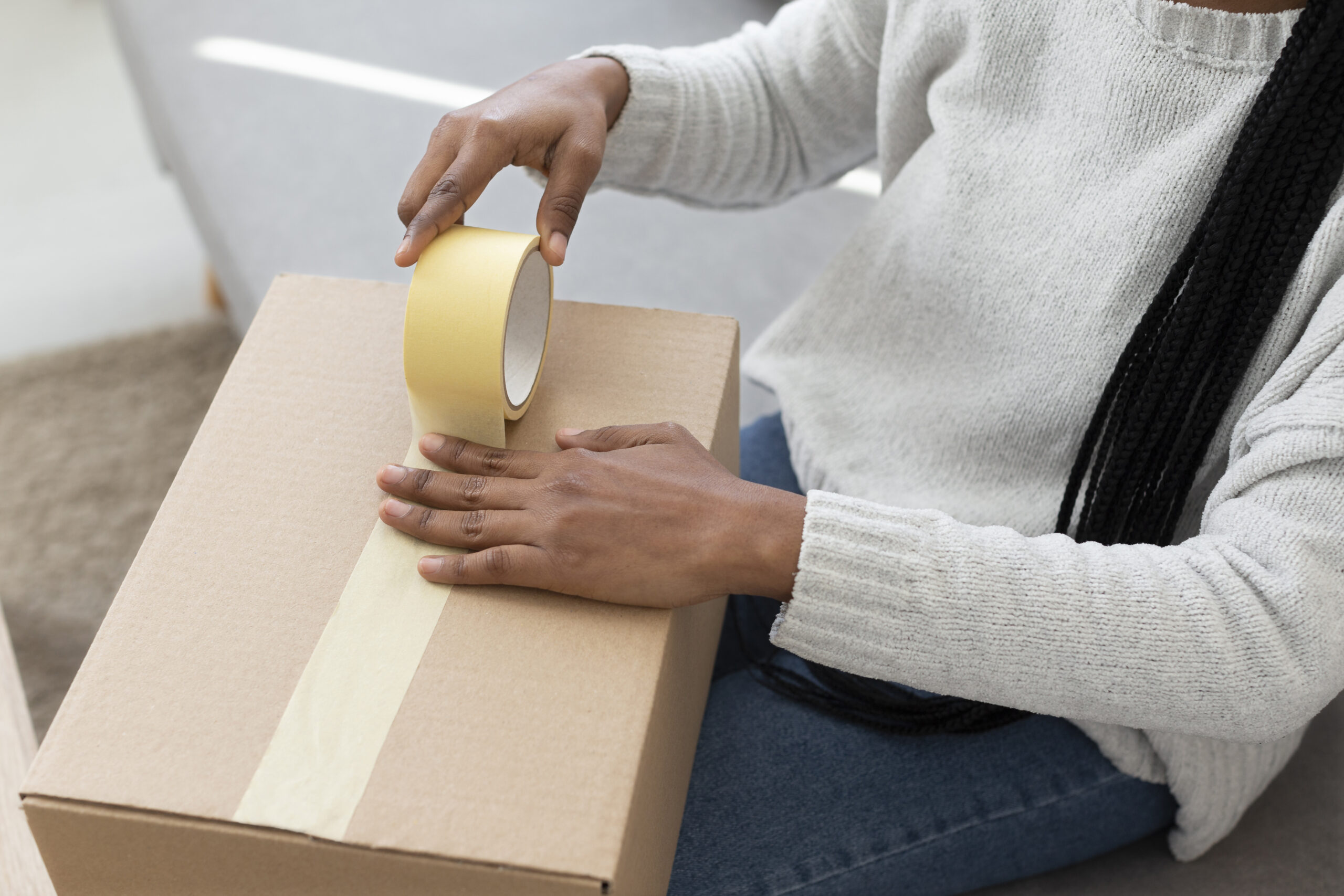How to Tape Moving Boxes Properly for Maximum Strength and Security
Get Your Free Moving Estimate
Imagine packing every item, stacking boxes, and watching the moving truck leave. Then, you open a box at your new home and see a crack. It’s a moment no one wants. That’s why learning to tape boxes right is crucial.
It’s not just about packing. It’s about protecting your stuff from damage. This guide will show you how to make boxes strong. You’ll learn the H-taping method and avoid common mistakes. A little extra taping can save you a lot of stress later.

Essential Supplies for Taping Moving Boxes
Before you start how to tape moving boxes, make sure you have the right stuff. The right tools help keep your boxes closed and safe on the move. They also save you time and prevent messes.
Choosing the Right Packing Tape
Packing tape is key. Don’t use regular cellophane or masking tape; they can’t handle heavy stuff. Go for strong packing tape made for moving, like Scotch Heavy Duty or Tuck Tamperproof. Choose clear or colored tape with a strong stick.
Stay away from duct tape; it’s too sticky for boxes.
Additional Tools You’ll Need
- A tape dispenser with a sharp blade cuts tape cleanly every time.
- Scissors for trimming excess tape.
- A permanent marker to label boxes after sealing.
- Knee pads or a work mat for comfort while working on floors.
How Many Tape Rolls to Purchase
For regular moves, figure on 1 roll for every 20-25 boxes. Get more for big items like dressers or TVs. Remember, it’s smart to buy 2-3 extra rolls to avoid running out.
Most stores sell tape in 50-yard rolls. Make sure to check the box sizes before you buy.
Preparing Your Boxes Before Taping
Before you start taping, it’s important to prepare your boxes right. This ensures the tape sticks where it counts. First, check each box for any tears or weak spots. If a box is damaged, throw it away. Flimsy boxes won’t hold up, no matter how much tape you use.
- Use cardboard scraps to reinforce weak areas inside seams. This adds hidden strength for when you move them.
- Make sure to fold the flaps tightly so they line up perfectly. Press the corners flat with your fingers before sealing. This makes clean seams for the tape to stick to.
- Lightly tape the top flap first if you’re packing heavy items like books. This keeps the contents inside before you seal it all up with the H-taping method later.
Don’t forget about the weight of your boxes. Overstuffed boxes can burst, even with the best tape. Always check the weight limits on the bottom flap of the box. For example, wardrobe boxes can hold up to 30 pounds and dishpacks up to 35. Pack fragile items lightly to avoid too much strain.
Pro tip: Test the box’s stiffness by gently squeezing the sides. If it flexes too much, you need to add more cardboard. This simple check saves time and prevents problems when unpacking. Once your boxes are set, the actual taping in how to tape moving boxes becomes more effective. Skipping these steps can put your belongings at risk. Think of this as building a strong base for your packing guide.
The H-Taping Method: How to Tape Moving Boxes Effectively
Learning to tape moving boxes right starts with the H-taping method. It’s a technique used by pros. This method keeps boxes sealed, even during tough moves. Let’s go through it step by step.
Step-by-Step H-Taping Technique
- Start by opening the box lid. Put a strip of packing tape along the center of the top and bottom seams. Press hard to stick well.
- Then, tape the ends of the box’s top flap, making a horizontal line. This is the first part of the H.
- Last, add vertical strips on the sides. These connect the cross to form an H. Make sure to overlap tape edges for full coverage.
When smoothing tape, use steady pressure to avoid air bubbles. For corrugated boxes, line tape with the box’s grain for a stronger hold.
Why the H-Method Provides Superior Strength
The H-pattern spreads the weight evenly, like building crossbeams. This makes it strong against stacking and shifting. The tape lines also strengthen corners and seams, preventing splits under heavy loads.
When to Use Double-Taping for Extra Security
For fragile or heavy items like books or dishes, use double-tape. Add a second H-pattern over the first tape for areas under stress. This boosts security without weakening the box.
Practicing this method ensures your boxes arrive safely. Remember, learning how to tape boxes right saves time and stress. Start with the H-method today!
Common Box Taping Mistakes to Avoid
Making small errors while taping moving boxes’ seams can cause big problems. These mistakes weaken boxes, risking damage to contents. Learn how to avoid them and protect your belongings better.
Using the Wrong Type of Tape
Masking tape, painter’s tape, or old tape dries out over time. These materials fail underweight or friction.
Solution: Use packing tape like Scotch Heavy Duty or Duck brand. Always check tape freshness and adhesion strength.
Not Sealing Bottom Seams Properly
Bottom seams bear the most weight when stacked. Leaving gaps lets moisture in and stress out.
Risk: Boxes can burst open mid-move.
Fix: Seal bottom flaps with double H-taping layers. Add extra strips for heavy items like books or glassware.
Applying Too Little Tape
One strip might seem enough, but it’s a gamble. Thin layers peel or snap under strain.
Pro tip: Use 2-3 parallel strips per seam. Corners and seams need full coverage for lasting strength.
Avoid these pitfalls to master how to tape moving boxes correctly. Quality materials and thorough methods keep your items safe during every move.
Special Taping Techniques for Different Box Types
Moving needs a flexible approach when how to tape a moving box changes with each item. Adjust your method for each box’s shape and what’s inside for the best protection:
- Wardrobe Boxes: Use double H-tape lines on the top lid. Add vertical strips on the sides to keep the hanging bar steady and prevent the box from tipping.
- Dish Packs: Make cross-hatch patterns on the lid and base. Wrap each plate in its sleeve before stacking. Then, seal the edges tightly to keep them in place.
- Book Boxes: They often get too full. Tape the bottom seam with triple H tape. Don’t fill them too high to avoid splits.
- Mirror/Art Boxes: Secure glass with an X-shaped tape frame on the front. First, tape the box’s bottom. Then, wrap the artwork in bubble wrap and place it in the center. Seal all edges after.
- Electronics: Wrap TVs in anti-static film. Use reinforced tape on seams and add corner guards. For big appliances, tape straps to the box’s sides for easier lifting.
- Mattress Boxes: Use wide packing tape on top and bottom seams. Reinforce handle areas with extra tape for safe lifting without tears.
Test each sealed box by lifting it from the bottom. Flexible tape patterns keep heavy or bulky items safe during transit. Adjust the tape’s thickness based on the item’s weight and how fragile it is.
Taping Fragile Items: Extra Security Measures
Protecting breakables during a move needs more than just taping. Follow these steps to secure fragile items well. Use proper techniques from how to tape moving boxes guides:
Reinforcing Boxes Containing Breakable Items
- Double-box small items by placing them inside a smaller box first, then into a larger one.
- Create cardboard corner guards by rolling sturdy paper into tubes and securing them with tape at box edges.
- Wrap items in bubble wrap before placing them in the box to absorb shocks.
Using Internal Tape Support Structures
Strengthen box integrity with internal braces:
- Cut strips of packing tape into 6-inch lengths.
- Form X-shaped braces across the box interior before placing items inside.
- Secure items in place with tape dividers between layers of dishes or glassware.
Labeling Properly After Taping
Add clear markings to demand care during transport:
- Stamp “FRAGILE” in bold letters using waterproof markers.
- Draw arrows showing the correct box orientation.
- Write “This Side Up” on the top flap after sealing.
Combine these methods with how to tape moving boxes best practices from earlier sections. When packing heirlooms or glassware, always layer bubble wrap first, then apply reinforced taping. Professional movers recommend this hybrid approach to prevent damage during transit.
Professional Moving Tips: What Movers Want You to Know About Box Taping
Movers handle thousands of boxes every year. They share their top tips to make your move smoother:
- Test the seal first. Movers shake boxes gently. If they move or feel loose, they’ll ask you to re-tape. Use how to tape a moving box method to keep seams tight.
- No “wishful taping.” If a box looks unstable, it’s rejected. Use the H-method to tape seams twice. This keeps fragile items safe.
- Weather matters. Cold weather weakens tape. Use weather-resistant tape from brands like Duck or 3M for outdoor moves.
- Weight = tape strength. Heavy boxes (over 30 lbs) need extra care. Reinforce corners with more tape where stress points are.
Professional crews stack boxes based on how well they’re taped. Well-taped boxes go on top. Poorly taped ones are flagged. Insurance claims often depend on proper sealing. Improper how-to-tape moving box methods can void coverage for damaged items.
Remember: Movers put safety first. Listen to their advice. Your belongings are worth the extra effort.
Conclusion: Securing Your Move One Box at a Time
Moving Soon? Here’s How to Secure Your Belongings the Right Way!
Packing properly starts with the right taping technique. The H-taping method is the best way to keep your boxes sealed and your valuables safe during transit. Start with strong packing tape—weak tape won’t hold up. Apply the H-pattern to reinforce all seams, making sure the bottom of the box is well-sealed to prevent breaks or leaks. For extra protection, label fragile boxes so they’re handled with care.
A little extra effort now can save you from damaged items and a stressful move later. Want professionals to take care of the hard part? Mustang Moving is here to help!
Schedule your consultation today!
